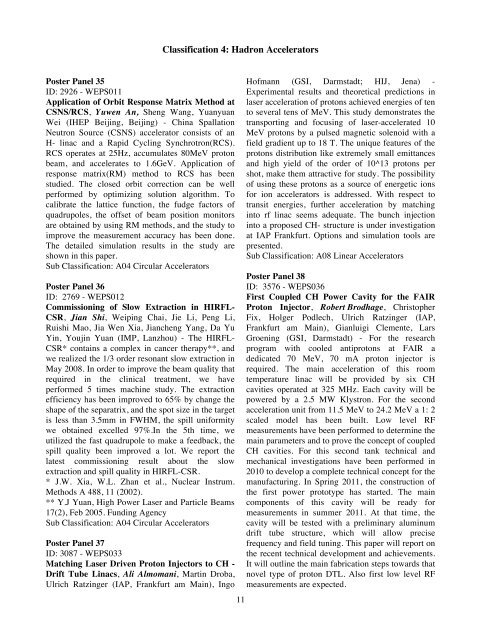Abstracts Brochure - 2nd International Particle Accelerator Conference
Abstracts Brochure - 2nd International Particle Accelerator Conference
Abstracts Brochure - 2nd International Particle Accelerator Conference
You also want an ePaper? Increase the reach of your titles
YUMPU automatically turns print PDFs into web optimized ePapers that Google loves.
Poster Panel 35<br />
ID: 2926 - WEPS011<br />
Application of Orbit Response Matrix Method at<br />
CSNS/RCS, Yuwen An, Sheng Wang, Yuanyuan<br />
Wei (IHEP Beijing, Beijing) - China Spallation<br />
Neutron Source (CSNS) accelerator consists of an<br />
H- linac and a Rapid Cycling Synchrotron(RCS).<br />
RCS operates at 25Hz, accumulates 80MeV proton<br />
beam, and accelerates to 1.6GeV. Application of<br />
response matrix(RM) method to RCS has been<br />
studied. The closed orbit correction can be well<br />
performed by optimizing solution algorithm. To<br />
calibrate the lattice function, the fudge factors of<br />
quadrupoles, the offset of beam position monitors<br />
are obtained by using RM methods, and the study to<br />
improve the measurement accuracy has been done.<br />
The detailed simulation results in the study are<br />
shown in this paper.<br />
Sub Classification: A04 Circular <strong>Accelerator</strong>s<br />
Poster Panel 36<br />
ID: 2769 - WEPS012<br />
Commissioning of Slow Extraction in HIRFL-<br />
CSR, Jian Shi, Weiping Chai, Jie Li, Peng Li,<br />
Ruishi Mao, Jia Wen Xia, Jiancheng Yang, Da Yu<br />
Yin, Youjin Yuan (IMP, Lanzhou) - The HIRFL-<br />
CSR* contains a complex in cancer therapy**, and<br />
we realized the 1/3 order resonant slow extraction in<br />
May 2008. In order to improve the beam quality that<br />
required in the clinical treatment, we have<br />
performed 5 times machine study. The extraction<br />
efficiency has been improved to 65% by change the<br />
shape of the separatrix, and the spot size in the target<br />
is less than 3.5mm in FWHM, the spill uniformity<br />
we obtained excelled 97%.In the 5th time, we<br />
utilized the fast quadrupole to make a feedback, the<br />
spill quality been improved a lot. We report the<br />
latest commissioning result about the slow<br />
extraction and spill quality in HIRFL-CSR.<br />
* J.W. Xia, W.L. Zhan et al., Nuclear Instrum.<br />
Methods A 488, 11 (2002).<br />
** Y.J Yuan, High Power Laser and <strong>Particle</strong> Beams<br />
17(2), Feb 2005. Funding Agency<br />
Sub Classification: A04 Circular <strong>Accelerator</strong>s<br />
Poster Panel 37<br />
ID: 3087 - WEPS033<br />
Matching Laser Driven Proton Injectors to CH -<br />
Drift Tube Linacs, Ali Almomani, Martin Droba,<br />
Ulrich Ratzinger (IAP, Frankfurt am Main), Ingo<br />
�<br />
Classification 4: Hadron <strong>Accelerator</strong>s<br />
11<br />
Hofmann (GSI, Darmstadt; HIJ, Jena) -<br />
Experimental results and theoretical predictions in<br />
laser acceleration of protons achieved energies of ten<br />
to several tens of MeV. This study demonstrates the<br />
transporting and focusing of laser-accelerated 10<br />
MeV protons by a pulsed magnetic solenoid with a<br />
field gradient up to 18 T. The unique features of the<br />
protons distribution like extremely small emittances<br />
and high yield of the order of 10^13 protons per<br />
shot, make them attractive for study. The possibility<br />
of using these protons as a source of energetic ions<br />
for ion accelerators is addressed. With respect to<br />
transit energies, further acceleration by matching<br />
into rf linac seems adequate. The bunch injection<br />
into a proposed CH- structure is under investigation<br />
at IAP Frankfurt. Options and simulation tools are<br />
presented.<br />
Sub Classification: A08 Linear <strong>Accelerator</strong>s<br />
Poster Panel 38<br />
ID: 3576 - WEPS036<br />
First Coupled CH Power Cavity for the FAIR<br />
Proton Injector, Robert Brodhage, Christopher<br />
Fix, Holger Podlech, Ulrich Ratzinger (IAP,<br />
Frankfurt am Main), Gianluigi Clemente, Lars<br />
Groening (GSI, Darmstadt) - For the research<br />
program with cooled antiprotons at FAIR a<br />
dedicated 70 MeV, 70 mA proton injector is<br />
required. The main acceleration of this room<br />
temperature linac will be provided by six CH<br />
cavities operated at 325 MHz. Each cavity will be<br />
powered by a 2.5 MW Klystron. For the second<br />
acceleration unit from 11.5 MeV to 24.2 MeV a 1: 2<br />
scaled model has been built. Low level RF<br />
measurements have been performed to determine the<br />
main parameters and to prove the concept of coupled<br />
CH cavities. For this second tank technical and<br />
mechanical investigations have been performed in<br />
2010 to develop a complete technical concept for the<br />
manufacturing. In Spring 2011, the construction of<br />
the first power prototype has started. The main<br />
components of this cavity will be ready for<br />
measurements in summer 2011. At that time, the<br />
cavity will be tested with a preliminary aluminum<br />
drift tube structure, which will allow precise<br />
frequency and field tuning. This paper will report on<br />
the recent technical development and achievements.<br />
It will outline the main fabrication steps towards that<br />
novel type of proton DTL. Also first low level RF<br />
measurements are expected.


